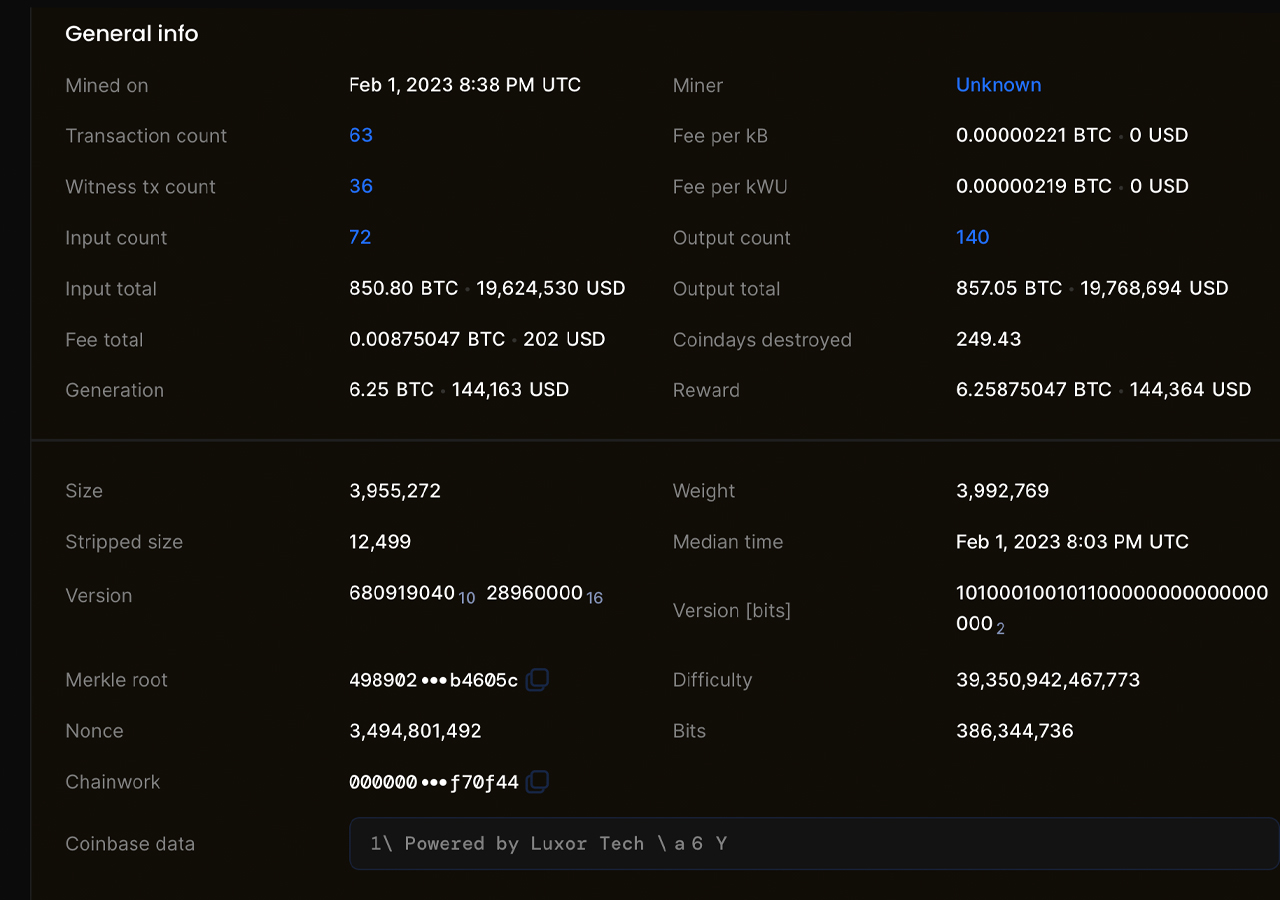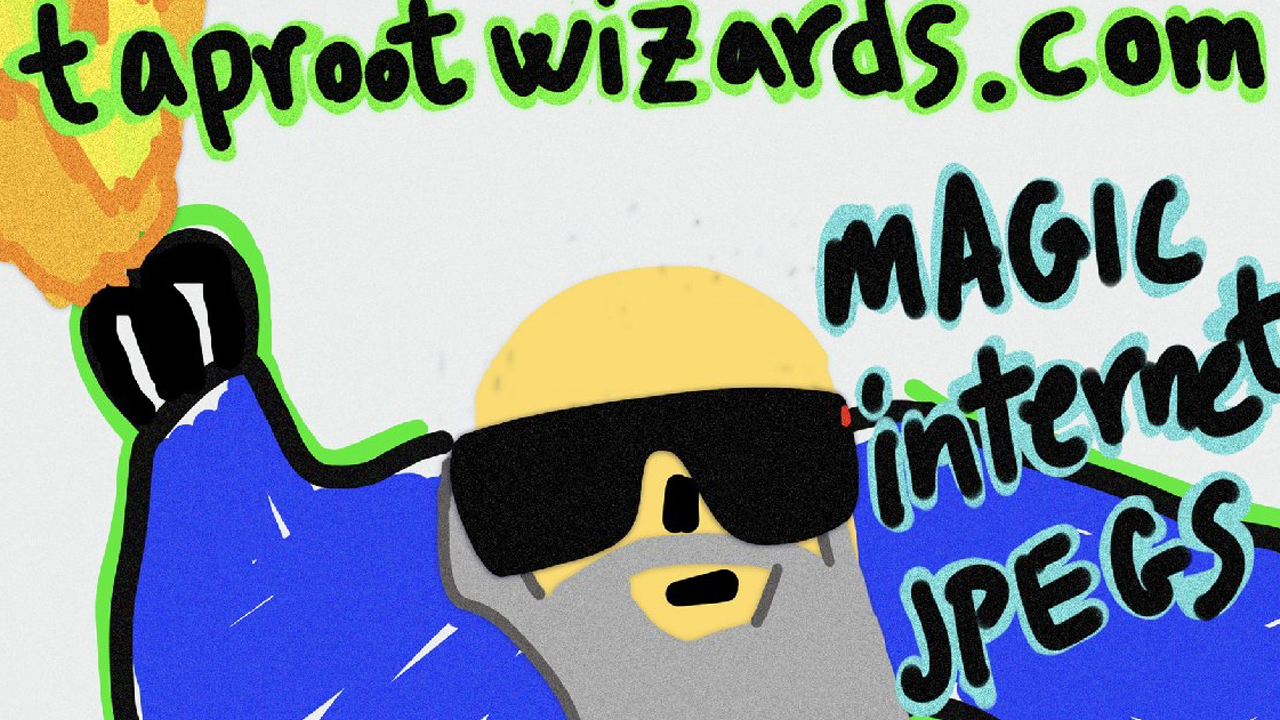Amid the controversy surrounding the Ordinals project and the debate over what types of data should be stored on the Bitcoin blockchain, the network mined its largest block, nearly 4 MB in size, containing just 63 transactions. One of the transactions was a 3.94 MB Ordinal inscription featuring an image of a wizard, and the Bitcoin-issued non-fungible token (NFT) has generated significant discussion.
Small Block Advocates Speak Out Against the 4 MB Bitcoin Block With NFT Inscription
On Feb. 1, 2023, the Luxor mining pool mined the largest block (#774,628) ever recorded on the Bitcoin network, approximately 3.96 MB. The coinbase parameter of the block contains a message indicating its discovery by Luxor. The mining pool also took to Twitter to inform the community about the discovery and the reason for the large size of the block.
“Last night, Luxor harnessed its magic energy and freed an ancient wizard from his cosmic cage where he had been trapped for many epochs,” the mining pool tweeted. “Keen observers of the chain of time may have noticed a 4 MB anomaly, unlike anything seen before. Will there be others?” The tweet also included an image of the “Taproot Wizard,” an Ordinal inscription #652, attached to the block. Taproot, a feature applied to the Bitcoin network on Nov. 12, 2021, was activated at block height 709,632 and brought several new benefits to BTC users.
A 3.96 MB block #774628 has been just added to Bitcoin by @LuxorTechTeam exploiting buggy Taproot! The previous record was just 2.77 MB. Here’s the list of the largest blocks: https://t.co/LsavqjLFEq
This will trigger many! Are we on the verge of a new blocksize war? 🤓
— Nikita Zhavoronkov (@nikzh) February 2, 2023
Essentially, Taproot allows multiple participants in a transaction to create a single combined digital signature, making transactions more efficient and private. Since the creation of Ordinals, it has been discovered that using a Segregated Witness (Segwit) “discount” in combination with Taproot allows for a full block to be 4 MB in size, bypassing the 1 MB limit encoded in the Bitcoin blockchain. It was previously known that Segwit slightly increased block sizes, with the largest block before Luxor’s 3.96 MB being 2.765 MB (#748,918) mined on Aug. 11, 2022.
Concerns Raised Over Immutable Nature of Bitcoin and So-Called ‘Dangerous’ Content
Meanwhile, Ordinals were already controversial among some bitcoin maximalists, and the 4 MB block mined with only 63 transactions and a Wizard JPEG caused further upset. For instance, bitcoin developer Luke Dashjr, who called Ordinals an “attack,” quickly created a node patch to filter or censor Ordinal “spam.” “NOT a protocol change or soft fork/hard fork, just a harmless (if it works right) spam filter,” Dashjr wrote. “Also a quick hack and NOT suitable for opening a PR to Core – please write a proper fix for that.”
 The record-breaking 3.96 MB Bitcoin block (#774,628) mined on Feb. 1, 2023.
The record-breaking 3.96 MB Bitcoin block (#774,628) mined on Feb. 1, 2023.
Many bitcoin advocates were dissatisfied with the record-breaking block size, and the topic was discussed on the Reddit forum r/bitcoin. The most upvoted comment in the thread read: “I would much rather see such a block full of real monetary transactions from thousands of people, instead of this idiocy.”
Another individual agreed with this opinion and argued that the Taproot scheme that produced a 4 MB block was dangerous. “Yeah … This is rather dangerous. We’re one bad actor or one automated miner away from cementing vile and disgusting things to a permanent, globally distributed, uncensorable database. It will be interesting to see if there is a free market solution to this.”
Someone has just uploaded DOOM to the BTC blockchain.
Go here to try it out:https://t.co/DLuBYj06CS
— Hector Lopez (@hlopez_) February 2, 2023
In addition to the stir caused by the Wizard-block Ordinal, an unsavory image was inscribed into inscription #668. Although the image was removed from the Ordinals website, it remains immutable and cannot be removed from the Bitcoin blockchain. Furthermore, a game, “DOOM,” was uploaded to the blockchain and can be found in inscription #466.
Some bitcoin advocates expressed dissatisfaction with the mining pool Luxor, which mined the 4 MB block. One person responded to Luxor’s tweet, saying, “There’s nothing revolutionary in what you did. You stuffed a nasty JPEG with zero artistic value into the blockchain. Okay…you could have crafted the same stupid image 10,000 times smaller. Why did you make it 4 MB? Because it’s mischief; you are trolls.”
Tags in this story
artistic value, automated miner, bad actor, Bitcoin, bitcoin maximalists, Block Size, Blockchain, Censorship, controversy, Cryptocurrency, dangerous, Decentralized, Developer, Digital Art, Digital Collectibles, digital market, digital ownership, free market solution, Hardfork, idiocy, immutable, Innovation, Luke Dashjr, Luxor, mining pool, mischief, monetary transactions, nft, node patch, ordinals, Ownership, Privacy-preserving, protocol change, r/bitcoin, Reddit, Scarcity, Security, Segragated Witness, SegWit, softfork, Taproot, transactions, Transparency, uncensorable database, upvoted, upvoted comment, virtual assets, wizard
What is your take on the 4 MB block controversy in the Bitcoin network? Do you believe it is a potential threat or a harmless addition to the blockchain? Share your thoughts in the comments section below.
![]()
Jamie Redman
Image Credits: Shutterstock, Pixabay, Wiki Commons, Editorial photo credit: Ordinal inscription #652
Disclaimer: This article is for informational purposes only. It is not a direct offer or solicitation of an offer to buy or sell, or a recommendation or endorsement of any products, services, or companies. Bitcoin.com does not provide investment, tax, legal, or accounting advice. Neither the company nor the author is responsible, directly or indirectly, for any damage or loss caused or alleged to be caused by or in connection with the use of or reliance on any content, goods or services mentioned in this article.

